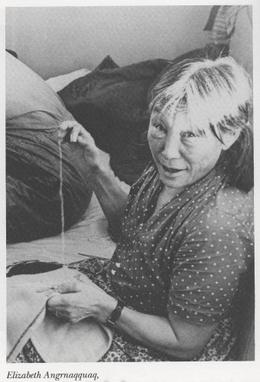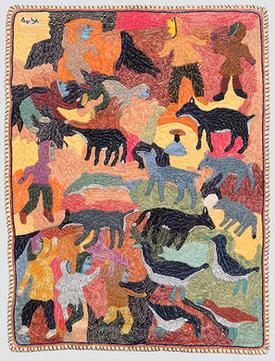Elizabeth Angrnaqquaq facts for kids
Quick facts for kids
Elizabeth Angrnaqquaq
|
|
|---|---|
 |
|
| Born |
Anakoak/Arngnatkoak/Arnatquaq
1916 Nunavut, Canada
|
| Died | 2003 |
| Style | Textile |
Elizabeth Angrnaqquaq (1916–2003) was a talented Canadian Inuk artist. She was known for her amazing textile art, which she created from the 1970s until the early 2000s. Elizabeth loved to try new ways of making art with fabric. People often said her style was like a painting, because she filled the spaces between her figures and animals with beautiful embroidery.
Contents
Elizabeth Angrnaqquaq: Her Life Story
Her Early Life
Elizabeth Angrnaqquaq was born in 1916 in what is now Nunavut, Canada. Back then, it was called the Northwest Territories. She grew up in a traditional nomadic camp, which means her family moved from place to place. Her mother passed away when Elizabeth was young, so her father raised her and her younger brothers and sisters.
Elizabeth lived a traditional Inuit life for many years. But in the 1950s, her family moved to Baker Lake to find a better life and avoid hardship. Her son, Harold, even worked at a sewing center there in the late 1960s. In Baker Lake, Elizabeth began to explore art using textiles and other materials. She used stitching to create figures and designs on fabric. She got her fabrics from Jack and Sheila Butler, who were art advisors visiting the Baker Lake area.
Becoming an Artist
Elizabeth Angrnaqquaq became very good at creating art with textiles. She explored different scenes like landscapes, animals, and textures using a special stitch called herringbone stitching. Soon, her artworks were shown in art galleries and museums across Canada.
In 1976, Elizabeth was asked to create a large artwork for the Post Office in Wakefield, Ontario. This was a special public art project. Her art was shown in many cities across North America, including Toronto, San Francisco, New York, Los Angeles, and Winnipeg. She created both private and public artworks.
Elizabeth continued to work on her art even when she was in her 80s! Her last known artwork, called Animals and People, was made in 2000. This piece uses bright colors and shows animals within an abstract landscape. She used the same herringbone stitch she was famous for.
Elizabeth Angrnaqquaq passed away in 2003, leaving behind a wonderful collection of textile art.
Where to See Her Art
You can find Elizabeth Angrnaqquaq's amazing artworks in these permanent collections:
- National Gallery of Canada
- Winnipeg Art Gallery
- Canada Council Art Bank


